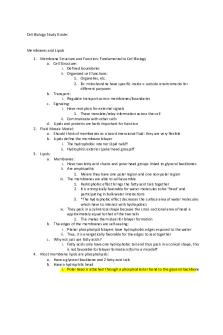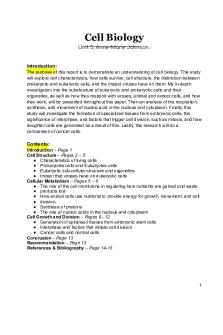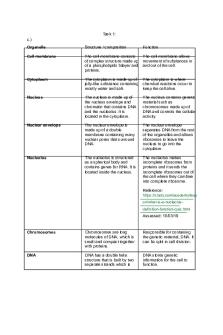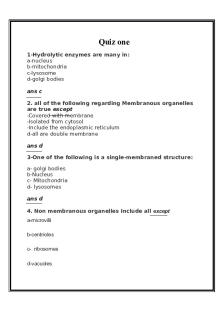Adam\'s Cell Biology- Exam 5 Study Questions PDF

| Title | Adam\'s Cell Biology- Exam 5 Study Questions |
|---|---|
| Author | Randall Reese |
| Course | Cell Biology |
| Institution | Utah State University |
| Pages | 7 |
| File Size | 82.6 KB |
| File Type | |
| Total Downloads | 33 |
| Total Views | 159 |
Summary
Detailed topic study guides for Dr. Brett Adams cell biology course. These guides are divided by topic and contain essential concepts and principles taught in class. Have the necessary information to help students succeed on exams....
Description
Questions about GPCRs: 1. Plasma Membrane Receptors that couple to heterotrimeric G proteins are known by the following names: G Protein coupled receptors, Seven-transmembrane receptors, serpentine-7 receptors, big proteins 2. What is the agonist/ligand for the beta1-adrenergic receptors? Adrenaline or epinephrine 3. Ligand binding alters the conformation of the ______________ regions of the receptor? Cytoplasmic 4. GPCRs are coupled to what type of G proteins? Heterotrimeric G-proteins 5. GPCRS are a type of __________ receptor? Metabotropic 6. GPCRs often modulate ion channels_________. Indirectly 7. How many genes encode for GPCRs? 800 genes about 4% of all genes 8. GPCR are the protein targets of ______% of clinically prescribed drugs? 40-50% 9. Also the target of ___________ drugs, including marijuana and opiates? Recreation drugs 10. What is the name for a receptor for which the ligand remains unknown? Orphan receptor 11. What type of GPRCs are potential targets of new pharmaceutical agents? Orphan 12. Orphan drugs are developed to specifically treat ________, which is referred to as a _________ type of disease? Rare medical conditions, orphan disease 13. Heterotrimeric G proteins are involved in what? Cell signaling events 14. Galpha subunit functions as a what? Molecular switch 15. What type of activity does the subunit possess? Slow, intrinsic GTPase activity 16. What causes the alpha subunit to change its shape? It depends on whether it’s bound to GTP or GDP 17. What two subunits bind so tightly they function as a dimer? The beta and gamma subunit 18. What subunits of the G protein is prenylated? Alpha and gamma 19. What is the AH domain of a G protein? Is the alpha-helical domain which trap the nucleotide in its binding pocket 20. What the activity of the Galpha subunit when it is bound to GDP? Its inactive, and has a high affinity for GBy dimer 21. Where are the hydrophobic in the inactive state? The interaction surfaces of Galpha and GBy make contact with each other 22. When these surfaces become exposed through dissociation or rearrangement they interact with what? Downstream effectors 23. GPCRs also function as what? Guanine-nucleotide exchange factors GEFs 24. What is a GEF? They induce Galpha to release GDP by changing the shape of Galpha, so the affinity decreases 25. When does GTP bind Galpha? After it has released GDP 26. What is the concentration of GTP in cytosol? ~0.5mM 27. What is the concentration of GDP in cytosol? ~10-fold lower 28. What does GPCR activation induce? The Galpha subunit to release GDP, and the binding of GTP
29. What does the binding of GTP cause? A reduced affinity of Galpha for the GBy dimer, it dissociates. However in some cells they do not dissociate, they just shift so interaction sites become available. 30. What subunits interact with downstream effectors? Both the GBy dimer and the Galpha 31. Downstream effectors are usually activated or inhibited by G-protein subunits? Both 32. What enzyme is activated by Galpha-s? Adenylyl Cyclase 33. What does Adenylyl cyclase do? Converts ATP to cAMP 34. What enzyme is inhibited by GBy dimer? Voltage-gated Ca2+ channels 35. Signaling of G proteins can be independently blocked by ____________ certain proteins? Overexpressing 36. What are examples of over-expressed proteins that inhibit signaling? a. Carboxyl-terminus of GRK2 binds to and sequesters Gby dimers but has no effect of Ga b. Carboxyl-terminus of phospholipase C-B1 (PLC-B1) binds to and sequesters Gaq/11 but has no effect of GBy dimer 37. What is an effector antagonist? When a downstream effector blocks or inhibits signaling by a G-protein 38. Effector antagonist mechanism also known as what? Negative feedback 39. What do we know about the effector agonist mechanism? They do not accelerate GTP hydrolysis 40. What are G Protein-coupled receptor kinases (GRKs): Are specialized to phosphorylate only active GPCRs 41. What other proteins can phosphorylated GPCRs? Protein kinase A, and protein kinase C 42. What is arrestin? A protein that binds to GPCR after it has been phosphorylated 43. What does arrestin doe? Inhibits coupling of GPCR to G-proteins 44. Arrestin also acts as an adaptor protein for what? Clathrin 45. What happens to internalized GPCRs? May be destroyed in lysosome, or continue to signal in different way 46. What are the four cellular processes that can block signaling through GPCRs? Inactivation, sequestration (into recycling endosomes), desensitization, downregulation 47. What has been highly useful in studying GPCRs? Yeast 48. Yeast’s GPCRs and heterotrimeric G-proteins are _____________ with those of humans? Evolutionary conserved 49. What is yeast mating factor? It is a peptide that related to luteinizing hormone, and it is a agonist for GPCR 50. Where is luteinizing hormone secreted? The anterior pituitary gland 51. What are the two states of yeast? Haploid or diploid 52. What does mating involve? The secretion of the mating factor, and then fusion of two haploid cells to create a diploid 53. The response to mating factor is called what? Shmooing 54. Where does the term Shmo originate? From Al Capp in a new comic called Li’l Abner 55. How long to alpha subunits require to hydrolyze GTP? 10 minutes acting alone
56. What is a GAP? GTPase accelerating proteins, some types are involved in most Gprotein signals 57. What are regulators of G-protein signaling (RGS)? Proteins that act as GAPS for heterotrimeric G-proteins, are responsible for high speed 58. What specific reaction requires high speed hydrolysis? Visual phototransduction 59. Why is GTP hydrolysis critical? Terminates signaling 60. How many different RGS proteins are known? 30 61. RGS proteins accelerate GTP hydrolysis up to ________ fold? 1000-fold 62. RGS proteins accelerate both the ________ and the ________ of G proteins mediated processes? Onset, and termination 63. What are effector GAPs? When downstream effectors also function as GAPS 64. What is an example of an effector Gap? Phospholipase C-B1 inactivates Ga-q/11 65. Effector Gaps are a form of what feedback? Negative 66. How many G protein subunits have been described in humans? 20 alpha, 6-beta, 11gamma 67. What does Galpha-q/11 activate? Phospholipase C-B1 68. What does Galpha-12/13 activate: RhoGEF 69. What is RhoGEF? Is the GEF (guanine nucleotide exchange factor) found in the monomeric G proteins of Rho/Rac/Cdc42 family. 70. The Rho family regulates what? The cytoskeleton 71. What does Cholera Toxin do? It ADP-ribosylates Galpha-s, and prevents GTP hydrolysis making signaling constitutive 72. What does Pertussis toxin do? It ADP-ribosylates Galpha-i/o, it blocks activation of G-i/o by GPCRs 73. What is the name for the disease caused by Pertussis toxin? Whooping Cough 74. What is Diphtheria? An acute infectious disease 75. What is Tetanus? A serious disease caused by bacteria that enter flesh wounds and produce tetanospasmin 76. What does Tetanospasmin do? Affect nervous system and leads to contractions in jaw and neck, interferes with ability to breath 77. What is tetanus commonly known as? Lock jaw 78. Is there a cure to tetanus? No 79. What is the DTaP immunization? Is a combination vaccine protects against diphtheria, tetanus, and pertussis, should be taken every 10 years 80. Different g-proteins achieve specificity in two ways? Have restricted expression in a particular cell types, and being restricted to certain cell locations Questions about Secondary Signaling Molecules 1. G proteins stimulate or inhibit downstream effectors, indirectly ,through what? Rapidly diffusible 2nd messengers 2. What are some secondary messengers? cAMP, cGMP, IP3, DAG, Ca2+ 3. How many isoforms of adenylyl cyclase are there? Nine 4. Galpha-S does what to adenylyl cyclase? Activates all nine isoforms 5. Galpha-i does what to adenylyl cyclase? Inhibits types 5 and 6
6. Gby dimer does what to adenylyl cyclase? Stimulates some isoforms, and inhibits others 7. What synthesizes cGMP? Guanylyl cyclase 8. What are the two types of guanylyl cyclases? a. Membrane-bound guanylyl cyclase and includes b. Soluble guanylyl cyclase 9. What domains does type 1 include? External ligand binding domain, transmembrane domain, intracellular catalytic domain 10. What are phosphodiesterases? Are enzymes that degrade cAMP and cGMP 11. What does phosphodiesterases degrade their substrate into? 5’-AMP, and 5’-GMP 12. Production of cAMP and cGMP is _______________ by their ___________ by phosphodiesterases. Counterbalanced, rapid degradation 13. How can cAMP be visualized in cells? Inject cells with protein that fluoresces when it binds cAMP 14. In cAMP visualization what does each color indicate? a. Blue = low concentration (5x10-8 M) b. Yellow = intermediate c. Red = high (10-6 M) 15. What neurotransmitters binds to GPCR that activate Galpha-s? Serotonin 16. What protein is activated by cAMP? Protein Kinase A 17. What is the structure of PKA? Has two catalytic domains and two regulator domains 18. How many cAMP much bind to each regulatory subunit in order to cause the catalytic domain to dissociate? 2 cAMP 19. The Catalytic subunits are _______ until the regulatory subunits dissociate? Inactive 20. The relationship between PKA and cAMP concentrations are _________ in certain concentrations? Linear 21. What is an example of cAMP’s rapid, short-term effects? When PKA phosphorylates and activites or inhibits cytosolic enzymes or ion channels 22. What is an example of cAMP’s long-term effects? When PKA enters the nucleus and alters gene transcription 23. What is CREB? When PKA enter nucleus it phosphorylates CREB 24. What is CBP? It binds phosphorylated CREB 25. What doe CREB and CBP act as? Transcription factors 26. What do CREB and CBP bind? cAMP response Element (CRE) 27. Where is CRE located and what does it do? It is located in a promoter region and binding of CREB and CBP upregulates gene transcription 28. Where can phosphatidylinositols be phosphorylate? On hydroxy head groups 3, 4, and 5 29. How many possible phosphatidylinositols are there? 7 total 30. What does PLC-B1 do? Cleaves PIP2 into IP3 and diacylglycerol 31. Where is PIP2 phosphorylated? On hydroxy 4 and 5 32. What does IP3 do? Opens ionotropic receptors of Ca+ channels in ER 33. What does DAG do? Remains in bilayer binds to Protein Kinase C 34. What is Protein Kinase C? Is a protein that associates with bilayer by binding to DAG. Becomes active when bound to DAG and calcium 35. Some Ca2+ signals are _____________ throughout a cell? Globally propagated
36. How do sperm affect Ca2+ concentrations? Introduce its own phospholipase C into egg,and trigger Ca2+ 37. What does the Ca2+ wave do for the egg? Triggers events that block other sperm from entering and initiates embryonic development 38. What mechanisms keep Ca2+ low in cell? Ca2+ ATPases, and Na+/Ca2+ exchanger 39. What types of ion channels allow Ca2+to flow into the cytosol from the ECF? VGCC, transient receptor potential channels (TRP), and nicotinic AChRs 40. What is the Ca2+ concentration in ECF? 1-2mM 41. What is the Ca2+ concentration in cytosol? 100nM 42. What channels sequester Ca2+ into intracellular mitochondria and ER/SR? Ca2+ ATPases 43. How is Ca2+ transiently released into cytosol? Through IP3 receptors and ryanodine receptors 44. Some cytosolic proteins bind and thereby _______ cytosolic Ca2+? Buffer 45. What are intracellular Ca2+ transients? Are short-lived, transient, increases in intracellular Ca2+ 46. What molecule was used to study Ca2+ transients? Arginine vasopressin (AVP), that activates Gq/11 47. What were cells loaded with to study Ca2+ transients? Aequorin, a fluorescent protein obtained from jellyfish 48. ___________ increasing with increasing AVP concentration, but ___________ did not? Frequency, height/duration 49. Ca2+ spikes involve regenerative positive feedback called what? Ca2+-induced Ca2+ release (CICR) 50. CICR is followed by what? Ca2+ dependent inactivation 51. Why do Ca2+ dependent inactivation occur? When Ca2+ levels get so high, the Ca2+ will have the effect of inactivating 52. Many Ca2+ dependent intracellular events are mediates by binding what? Calmodulin 53. When does calmodulin bind effector proteins? Only after binding Ca2+ 54. Sometimes calmodulin may be _____________ to its downstream effector. Constitutively tethered 55. What family is calmodulin apart of? EF-Hand family, that is known for its characteristic shape 56. What are some other members of the EF hand family? Troponin C, Recoverin, Frequenin? 57. What is other name is Frequenin? NCS-1 (neuronal calcium sensor-1) 58. Does Calmodulin activate or inhibit downstream effector proteins? Does both 59. What is CaMK? Ca2+ Calmodulin kinase that phosphorylates serine/threonine and is activated by CaM binding 60. What does calmodulin d to CaMK? Removes a self-inhibition of CaMK, by binding to inhibitor domain and preventing it from inhibiting the catalytic domain 61. CaMK exists as a _____-mer? 12 62. What two things have to activate CaMK? Calmodulin binding and autophosphorylation, which happens from catalytic domains to inhibitory domains
63. How many subunits have to autophosphorylated before CaMK runs independently? 2 subunits 64. What dephosphorylates active CaMK? Protein phosphatase 65. CaMK can _______ intracelluar Ca2+ transients? Integrate 66. CaMK can carry a _______ of recent intracellular Ca2+ signals because the activation of CaMK will not __________ between concentration spikes? Memory, return to baseline Questions about Kinases and Modular Proteins: 1. What are Kinases? Are enzymes that covalently attach a phosphate group from a highenergy donor such as ATP to a substrate molecule 2. What are examples of a substrate molecule for kinases? Protein, lipid, carbohydrate, amino acid, nucleotide 3. What is kinase consensus sequence? A specific recognizable sequence of amino acids that is located within the target proteins, where a kinase phosphorylates 4. What is the consensus sequence for PKA? R-R-X-S/T-Y 5. How many kinase genes do humans have? 500 6. What is an enzyme linked receptor? Transmembrane receptor proteins that may or may not have integral, intracellular kinase domain (kinase-linked) 7. What are Receptor Tyrosine Kinase (RTKs): These are transmembrane receptor proteins that do contain integral, intracellular tyrosine kinase domain 8. What are non-receptor tyrosine kinases? These are cytosolic tyrosine kinase enzymes that lack a transmembrane, ligand-receptor domain 9. How many subfamilies of Receptor tyrosine kinases are there? 7 10. What do Ephrin RTK stimulate? Stimulate angiogenesis, uses contact dependent signaling 11. How many human genes code for RTKs? 60 12. RTKs may be activated by ________ ligands? Dimerized 13. RTKS typically _______ upon ligand binding? Dimerize 14. What do RTKs dos when they are dimerized? They cross phosphorylate (transautophosphorylation) their partner on tyrosine residues 15. Trans-autophosphorylation creates__________ for intracellular signaling proteins? Binding sites/ docking sites 16. What type of domains on signaling proteins can bind phosphotyrosine? SH2 and PTB 17. When these binding site recruit intracellular signaling proteins they create __________ that activate specific signaling pathways? Signaling complexes 18. Phosphotyrosines residues function as docking sites for signaling proteins that contains ____________ that recognize phoshpotyrosine residues within a ________. Modular protein domains/ consensus sequences 19. What happens after ligand binds to Epidermal growth factor (EGF) receptor? One intracellular kinase domain (the activator) pushes against the other kinase domain (the receiver), activating its catalytic site 20. What can be used to identify intracellular tyrosine residues that serve as docking sites? Site-directed mutagenesis
21. What are modular protein domains? Modules that can be plugged into a variety of proteins without altering the protein's other functions 22. What are some examples of modular protein domains? a. SH2 and PTB: Bind phosphotyrosine residues b. SH3: Binds proline-rich regions c. PH: Bind PIP2, PIP3, and GBy subunits of heterotrimeric 23. Mutated RTKs may signal ________ even in the absence of extracellular agonist? Constitutively 24. Constitutive signaling may lead to abnormal proliferation leading to what? Tumor formation 25. What is the Angiogensis? The formation of new blood vessels from existing ones 26. How does angiogenesis affect tumor cells? Provides them with access to vital supplies, enables them to continue to grow 27. Tumor growth is limited by what? Blood supply 28. What stimulates angiogenesis? Vascular endothelial growth factor (VEGF) (VEGF receptors is a subfamily of RTK) 29. What monomeric G protein is activated by an RTK? Ras 30. What is Grb-2? An adaptor protein that binds phosphotyrosines on RTKs 31. What is Ras GEF? Is recruited by Grb-2 and binds to Grb-2. Then associates with Ras and activates it 32. Ras is the _______ monomeric G protein? Prototypical (first described) 33. Binding of what ligand to RTK activate Ras? EGF 34. Ras stands for what? Rat Sarcoma 35. How does ras associates with PM? Prenyl and palmityl 36. Ras functions as _______, and when is it active and inactive? Molecular switch, RasGTP is active, and Ras GDP is inactive 37. Ras possesses very _______ intrinsic GTPase activity so it relies on ______? Low, Ras GEF 38. What is Ras GDI? Guanine-nucleotide Dissociate inhibitors that prevent Ras from releasing GDP and being activated by Ras GEF 39. What is Ras GAP: Keeps Ras in GDP bound from 95% of the time 40. FRET indicates that Ras becomes active ______ following RTK activation. 41. Hyperactive Ras is ________? Oncogenic 42. _______% of all human tumors express hyperactive Ras? 30 43. What is activated by Ras? Map Kinase signaling cascade 44. What does MAP stand for? Mitogen-activated protein kinase 45. What is mitogen? Is a signaling molecules that trigger increase in cell number (proliferation) 46. What is the process of a Map kinase cascade? a. Ras binds to and activates Raf b. Raf phosphorylates many Mek c. Mek phosphorylates many ErK d. ErK phosphorylates a variety of proteins including transcription factors 47. Map Kinase signaling cascade greatly ______ the original signal? Amplifies...
Similar Free PDFs

Cell Biology Study Guide
- 37 Pages

Cell Biology unit (5)
- 14 Pages

Cell biology exam, answers
- 11 Pages

Unit 5 Cell Biology
- 18 Pages

Cell Biology Final Exam Study Guide
- 143 Pages

Unit 5 cell biology assignment
- 17 Pages

Cell biology
- 3 Pages

Cell Biology Quiz CELL ORGANELLES
- 10 Pages

CELL Biology EXAM 1 Outline-1
- 23 Pages

Unit 5- Cell Biology - Grade: PASS
- 17 Pages

Cell Biology Syllabus 2019
- 5 Pages
Popular Institutions
- Tinajero National High School - Annex
- Politeknik Caltex Riau
- Yokohama City University
- SGT University
- University of Al-Qadisiyah
- Divine Word College of Vigan
- Techniek College Rotterdam
- Universidade de Santiago
- Universiti Teknologi MARA Cawangan Johor Kampus Pasir Gudang
- Poltekkes Kemenkes Yogyakarta
- Baguio City National High School
- Colegio san marcos
- preparatoria uno
- Centro de Bachillerato Tecnológico Industrial y de Servicios No. 107
- Dalian Maritime University
- Quang Trung Secondary School
- Colegio Tecnológico en Informática
- Corporación Regional de Educación Superior
- Grupo CEDVA
- Dar Al Uloom University
- Centro de Estudios Preuniversitarios de la Universidad Nacional de Ingeniería
- 上智大学
- Aakash International School, Nuna Majara
- San Felipe Neri Catholic School
- Kang Chiao International School - New Taipei City
- Misamis Occidental National High School
- Institución Educativa Escuela Normal Juan Ladrilleros
- Kolehiyo ng Pantukan
- Batanes State College
- Instituto Continental
- Sekolah Menengah Kejuruan Kesehatan Kaltara (Tarakan)
- Colegio de La Inmaculada Concepcion - Cebu




